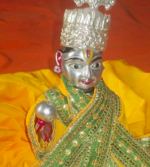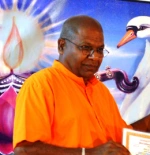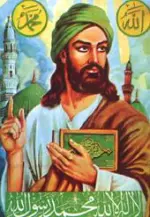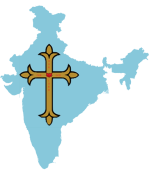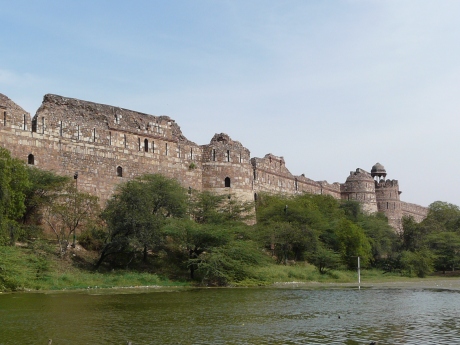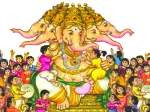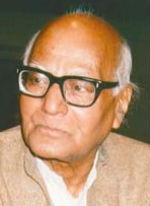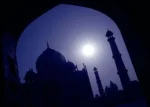 Indraprastha was founded as the capital of the Pandavas’ small-time kingdom but the area was destined by fate to become the capital of the Delhi Sultanate, the Moghul Empire, Samrat Hemachandra’s short-lived empire, British India spanning the whole subcontinent, and now the Indian Republic. It is a source of pride, and worth celebrating, that here, the “righteous ruler” once chose to highlight the great universal ideas personified in Indra. – Dr Koenraad Elst
Indraprastha was founded as the capital of the Pandavas’ small-time kingdom but the area was destined by fate to become the capital of the Delhi Sultanate, the Moghul Empire, Samrat Hemachandra’s short-lived empire, British India spanning the whole subcontinent, and now the Indian Republic. It is a source of pride, and worth celebrating, that here, the “righteous ruler” once chose to highlight the great universal ideas personified in Indra. – Dr Koenraad Elst
Indraprastha was the town founded by the Pandava brothers of Mahabharata fame as their capital. Here, the eldest among them, Yudhishthira, became the “ruler of righteousness” (dharma-râja). More than three thousand years later, on 22-23 November 2016, the Draupadi Dream Trust held the first Indraprastha Conference in the National Museum, Delhi. This was part of a larger initiative on Indraprastha, with an exhibition in the Purana Qila (Old Fort). This fort itself had been built over the ancient site of Indraprastha, now partly made visible by archaeological excavations.
Among secularists, there is predictably an attempt to sow doubt about this. In his 2015 book Where Stones Speak: Historical Trails in Mehrauli, the First City of Delhi, Rana Safvi argues that the finds under the Purana Qila have not been established to be the Pandavas’s city, which was but “mythological”. In particular, they are claimed not to contain the characteristic Painted Grey Ware, as per the 1954 excavations by India’s top archaeologist B. B. Lal. However, 62 years later, the nonagenarian Lal edited the brochure of the present exhibition and, taking into account several excavations since then (which Safvi feigns to ignore), he asserts that PGW was indeed found there, and that it was certainly the city of the Pandavas. Mehrauli was not the oldest part of Delhi, Indraprastha was.
(This repeats two earlier and similar attempts at secularist deception, involving the very same archaeologist. When Lal discovered the temple’s pillar-bases underneath the Babri Masjid, the secularists started nitpicking about his field-notes, when his final report was already in the public domain and affirmed the existence of the temple remains. And till today, defenders of the Aryan Invasion Theory keep on citing as proof of the invasion the identification by the young Lal of the PGW as showing the Aryan invaders on their way deeper into India, a view that he has long dismissed as immature. As ought to be well-known, Lal has for decades testified that there is no proof for this invasion whatsoever, and that Vedic India and the Harappan civilization were two sides of the same coin. In all the three cases, the secularists cite an early or even a non-existent position of Lal’s to trump his well-known mature position.)
 Lightning
Lightning
A prastha is an open space, a clearing in the forest where you go and settle, a “colony”. Thus, a vanaprastha, an elderly person who withdraws from society, is “one who goes and settles in the forest” or “one who has the forest as his colony”.
The new town was dedicated to Indra. He was the god of the thunderstorm that puts an end to the oppressive summer heat and opens the rainy season. That is why among the 12 Vedic solar months or half-seasons, he rules the first month of the rainy season. As the Rg-Vedic seer Vasishtha says in his celebrated Hymn of the Frogs, both the priests and the frogs croak with joy when the first rainstorm breaks: the frogs because of the advent of water, the priests because of the manifestation of their god, Indra. Implicitly, the priests’ recitation is humorously likened to the frogs’ croaking.
He was also the slayer of the dragon Vrtra, a model for all the dragon-slayers in the world, such as Zeus killing Typhon, or Saint George, or Siegfried, or Beowulf. In Iran, he was transformed into a demon, but his nickname Verethragna (Vedic Vrtrahan, “Vrtra-slayer”) then became a popular god in its own right. There, we have an Indra on the side of both good and evil.
Less poetically and more philosophically, the Atharva Veda puts him at the centre of the sophisticated concept of Indrajâla, “Indra’s net”. In this net, a diamond in every knot reflects every other diamond knot, and thus the whole. The West needed another four thousand years to develop the similar concept of the holographic paradigm.
In India, Indra’s cult gradually declined after the Mahabharata age. Originally an embodiment of masculine strength, he becomes the subject of poetic variations extolling his (and his wife Shachi’s) sexual prowess. Like his Greek counterpart Zeus, he gets involved in flings on the side, such as with sage Gautama’s wife Ahilya. While becoming a character of fun, he further gets disavowed by the Mahabharata hero Krishna. In the famous Govardhan episode, Krishna lifts a mountain and holds it like an umbrella over the common people to protect them from the storm, embodiment of Indra’s wrath. This spurs on the further decline of the Vedic gods and their replacement with the now-familiar Hindu pantheon. By the time Hindus start building temples in the last centuries BCE, Indra is no longer worshipped.
However, the Buddha arrived just in time for Indra to play a role in his career. it was Indra himself who persuaded the freshly awakened Shakyamuni to start preaching his newfound path. Buddhist monks then spread the cult of Indra to foreign lands as far as Japan. Indra’s weapon, the lightning or vajra, became the emblem of instant Enlightenment. The sought-after “Self-nature” (Chinese zixing) is present all the time, deep in all of us; but when we embark on the path of meditation and finally awaken to it, it strikes like lightning.
Dînpanah and the religion
When the Muslim conquerors incorporated the area into their capital and built the Old Fort there, it was apparently not a case of “a Hindu sacred site destroyed to make way for a showpiece of Muslim power”. Indraprastha had largely fallen in disuse centuries before the conquests, leaving pride of place to other parts of Delhi. Still, the conquerors were aware of the site’s past as Indraprastha, for in his Ain-i-Akbari, Moghul chronicler Abu’l Fazl writes that it had been built on the site of “Indrapat”. There was probably no explicitly communal angle to it when the Muslim rulers chose the Indraprastha site.
That changed when the second Moghul emperor Humayun decided to reorganize the area as his own glimpse of paradise, calling it Dînpanah, “refuge of Islam”. Dîn is the general Semitic word for “justice, righteousness”, even “religion” (roughly, dharma). It was in this sense that the syncretistic emperor Akbar was to use it when he founded the Dîn-i-Ilâhî, the “divine religion”. This new religion was meant as a confluence between Hinduism and Islam, symbolized by Akbar’s newly-founded city of Ilâh-âbâd (“divine city”, wrongly transcribed by the British as Allahabad) on the Ganga-Yamuna confluence. But this religion did not exist yet in Humayun’s time.
Akbar’s usage of Dîn accorded with its original Semitic meaning once used by the Arab Pagans. But it deviated from the meaning that Mohammed had conferred on the term during his rulership in Arabia: specifically the religion of Islam. It is in this more limited sense that the word came to be used in names like Saifu’d-dîn, “sword of Islam”, and likewise in Humayun’s Dînpanah, “refuge of Islam”. Humayun’s rulership of Delhi was short-lived, and when he finally recovered it, he found his Dînpanah in disarray. He did not get a chance to rebuild it for he died soon after. So, it only had a very fleeting existence and made no mark at all in Delhi’s long history. By contrast, the earlier town of Indraprastha had existed for many centuries.
Recently, some well-meaning but illiterate bureaucrat came up with the idea that Lutyens’ Delhi should be renamed as Dînpanah. However, naming a central neighbourhood of Delhi after a particular religion might not go down well with the preponderantly secular-minded population. Probably the bureaucrats who considered naming the area’s development project Dînpanah had not considered this because they had not realized the meaning of Dîn. At any rate, the plan was shelved when they learned of the far better credentials of Indraprastha.
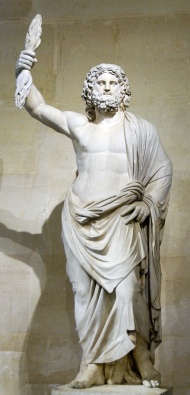 The god
The god
Now, some usual suspects will object upon hearing anything with the Vedic god Indra in it: “Communal!” They are mistaken. There is nothing communal about the holographic paradigm. There is nothing communal about sudden Awakening. He is the same storm god whom we find the world over: Zeus among the Greeks, Jupiter among the Romans, Thor among the Vikings (whence Thursday), Marduk in Babylon, Ba’al in the Levant. Note how Indra is likened to a bull, how Zeus seduced princess Europa in the shape of a bull, and how Ba’al was famously worshipped as a bull in the Biblical episode of the Golden Calf.
In fact, in the Golden Calf events, two faces of the storm god were in confrontation: not just Ba’al but even Moses’ god Yahweh are evolutes of essentially the same god. A lesser known face of the storm-god was indeed Yahweh among the Midianite Beduins in northwestern Arabia. Among them, then led by chieftain Jethro, the fugitive Egyptian prince Moses found asylum. That is when he acquired both a wife and a new religion. Yes, Yahweh was originally an Arab storm god, whose name was misinterpreted by the Bible authors as “He who is”. His name stems from a verbal root h-w-h also attested in the Quran, and meaning “to move in the sky”. This is both in the sense of the storm-wind’s blowing (an image of the palpable though subtle power of heaven) and of an eagle swooping down to catch its prey (an image of the sudden whims of destiny).
This Yahweh, this choleric storm god, was then taken to Egypt, apparently in the age when some of Pharaoh Akhnaton’s monotheistic reform was in the air. Next, he led Moses and the Israelites in the legendary Exodus through the desert. He remained powerful, sovereign and choleric, but was theologically transformed into the Biblical “jealous god”, who tolerates no second god beside him. This Yahweh, the sender of prophets, was later to be embraced by Mohammed under the name Allah, from al-Ilâh, “the god”.
Long live Indraprastha!
So, everybody can feel happy with the name Indraprastha. No Muslim invader ever destroyed a temple to Indra, for he had been worshipped before the Hindus even used idols housed in temples. Indra throwing the lightning (elsewhere “Thor’s hammer”) is an apt image of a heavenly intervention in earthly affairs. Everybody naturally considers thunder and lightning to be the prime symbol of heaven’s unchained might over us. Thus there is nothing communal about this name, on the contrary: Indra’s thunder storms are a pan-religious symbol, an embodiment of the basic unity underlying the plurality of religions.
Indraprastha was founded as the capital of the Pandavas’ small-time kingdom but the area was destined by fate to become the capital of the Delhi Sultanate, the Moghul Empire, Samrat Hemachandra’s short-lived empire, British India spanning the whole subcontinent, and now the Indian Republic. It is a source of pride, and worth celebrating, that here, the “righteous ruler” once chose to highlight the great universal ideas personified in Indra. Therefore, the open-minded Delhiites all agree: Indraprastha amar rahe! – Koenraad Elst Blog, 30 December 2016
» Dr Koenraad Elst is an indologist and historian from Belgium who publishes with Voice of India, New Delhi.
Filed under: india | Tagged: delhi, history, india, indian history, indra, indraprastha, mahabharata, pandava brothers | 2 Comments »


